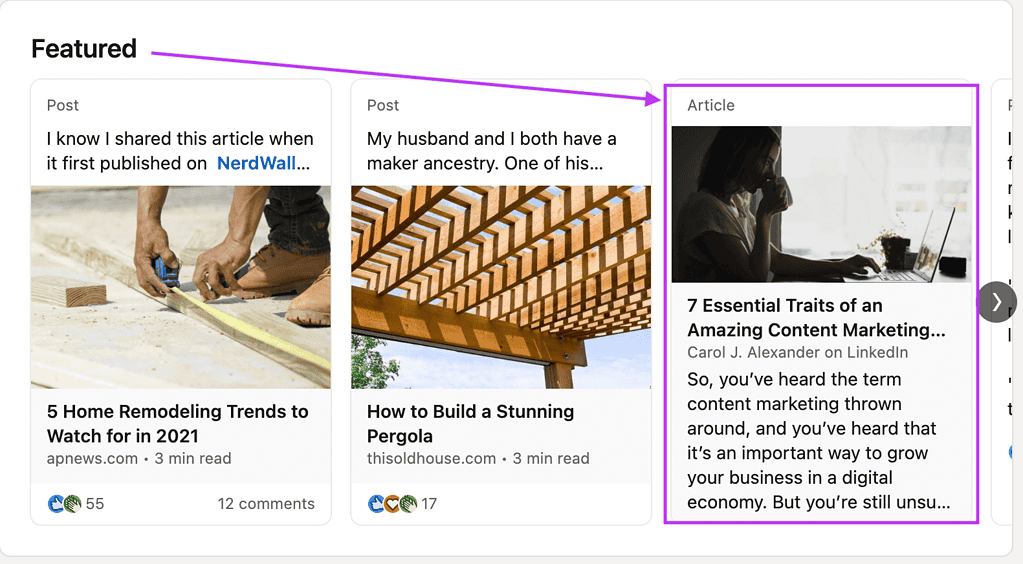Finding freelance writing gigs online can be frustrating.
But of all the types of social media out there you can use to promote your freelance writing, LinkedIn is one of the most useful. It’s a powerful way to find freelance jobs so you can make money writing.
In working with writers in my coaching program, I’ve discovered a lot of writers aren’t making full use of this platform.
But where do you get started? How exactly can you find LinkedIn freelance writing jobs? This post gives you a crash course on how to get started with LinkedIn marketing.
Why LinkedIn is the Perfect Place to Find Freelance Jobs
First off, here’s why I like LinkedIn and recommend you become active on it: Unlike Twitter, Facebook, Reddit, and many other platforms, LinkedIn is all business.
There’s nobody on there with a photo of themselves half-nekkid with a drink in their hand, where their bio says they just wanna par-tay, or that they watch Glee.
Folks are on LinkedIn to further their careers. Period.
That screens out a lot of the bullcrap that often turns social media into such a time suck.
Nobody’s playing silly games on here or asking you to watch some dumb video. The audience may be smaller than Facebook’s at about 67 million, but it’s a higher-quality group.
The huge potential of landing gigs through LinkedIn is why we’ve done a lot of training on this in the Freelance Writers Den. You can access tons of bootcamps plus over 300 hours of other trainings by becoming a Den member.
How, exactly, can you find jobs on LinkedIn? Here are the easiest, most effective ways I’ve found:
7 Ways You Can Land Freelance Jobs on LinkedIn
1. Use keywords in your profile
Start by fully filling out your profile and stuffing it with keywords about what you do. At one time, mine said “freelance writer, award-winning blogger, copywriter, and writing mentor,” but now it says “Freelance Book Ghostwriter & Traffic-Driving Blogger | Finance | Entrepreneurship” to better match my current freelance goals.
Why is using keywords one of the most essential LinkedIn headline tips?
Companies and publications that need a freelance writer search by keywords for the type of writer they’re looking for.
My profile also names my nearest major city, useful for people searching for a local writer — that’s how an airline magazine based in my town came to call me recently to write a $500 business-finance article. They’re not the only major company I’ve had call me cold off my LI profile, either.
So fill out your profile, people. Your profile converts people into buyers the best of any page on LI. People like to hang out in the groups (more on them later), but filling out your profile completely may be your most efficient use of time on LI.
2. Check “Who’s viewed my profile?”
A lot of people don’t realize you can click on this little sidebar widget and get more information about who has been looking at your LI profile.
Yes, if you’re only on the free level, sometimes it won’t show you much — some of the information will be hidden. A Premium membership is the way to go for a month or two, while you prospect heavily with this strategy.
But sometimes, it will reveal contact names.
If they smell like a prospect, I then send them a message: “Hi, were you looking for a freelance writer? I noticed you were looking at my profile. Let me know if there’s anything I can do to help!”
If I have particular expertise relevant to their industry, I mention that as well. I get a lot of responses to this, as people are amazed you knew they were checking you out.
3. Track down your editor connections
I find LI is the place to look up all your former editors (or marketing managers, if you’re a business writer).
Search for them and ask to connect.
Shmooze, catch up, find out what they’re doing now. Do they need a job? Send them leads. Do they have a job? Maybe they can use you again, or know another editor using freelancers and could refer you.
At one point when I was really needed a few new clients, I decided to reconnect with every editor I’d ever liked. It was fun! And one I hadn’t written for in a decade ended up referring me a great new global client that I did $1,000 of work for last year, and they’re still calling me.
4. Browse available job postings
If you’re going to look at online writing jobs, LI is one of my favorite places to do it, as an increasing number of their ads are exclusive to LI. Their ads cost money, and the companies tend to be high-quality.
I use one of my favorite ad-hunting tricks and look at LI’s full-time job ads. In my experience as a staffer, the appearance of a staff-writer job ad means a crisis situation-someone usually left months back.
My strategy? Apply to any publication or company of interest, and just let them know you’re a happy freelancer, not looking for a full-time job, but I’m so right for you, look at my experience…do you perhaps also work with freelancers?
I got a nice, $1-a-word client, an interesting national trade magazine, with this strategy. It’s great if you feel like you don’t want to bother people-because these people are warm leads. They’ve already been checking out your profile, so it’s a natural reach-out to ask if they need a writer.
5. Use InMail for prospecting
It’s hard to get emails delivered these days. You never know if you’re going in spam. Know what DOES stand out? Sending an InMail.
I’m not a believer in sending a full-blown pitch in an InMail-that’s a great way to get reported or blocked on LinkedIn as being too spammy. (Also, there’s a word limit.)
BUT… InMail is a great way to connect with prospects and see if they’re interested. And to get them to look in that spam folder and pull out your message, if it landed there.
A couple things I do:
Message #1 (right after connecting): Thanks for connecting! I’d love to learn more about your business and how I can help you. Right now, I’m looking to add a couple of freelance-writing clients in your industry. If you know anyone who’s looking for a writer, I’d appreciate your referrals. Let me know your ideal client, so I can return the favor.”
Message #2 (send anytime): “I’ve got some ideas that might help your business. Sent them over in an email – please be on the lookout for it!”
That’s right, instead of outright pitching people on LinkedIn, I often ask them to refer me leads. Why? It’s less obnoxious and likely to get you reported. People love to refer people! Makes them feel helpful.
And… if they actually need a writer, they’ll tell you. “Oh, but I need someone!” And boom, you’ve got a lead without selling anybody.
6. Pitch in connection invites
Here’s a strategy for the bold writer: Pitch your services directly in your connection invite. This saves a step from the approach of throwing out a ton of connection invites without saying why you want to connect… and then InMailing them (as in point 5) to pitch them afterwards.
We all know you’re seeking to connect because you want to see if they might hire you as a writer. So, just cut to the chase. Send an invite along the lines of:
To an editor: “Loved the recent article on X in the X issue! Are you accepting pitches right now? Would
love to send you an idea about Y. I also noticed we have X mutual connections, and thought
it would make sense to connect.”To a marketing manager: “I noticed your company is in X NICHE, which I write for. Looking through your site, I thought you may benefit from X and X TYPES OF CONTENT. Would love to connect here to chat about how I can help bring that content to life.”
Hat tip to Mandy Ellis for this one! This strategy is too aggressive for me personally, but Mandy and other writers I know report this can be a fast-acting way to line up new writing jobs.
7. Create a bait piece for your ‘Featured’ section
Recently, LinkedIn added a profile section called Featured. It lets you spotlight 3 of your best pieces in nice, big display boxes.
It’s a great opportunity to select what you want clients to see and learn about you. You’d think freelance writers would be all over this.
The reality: Almost no freelance writers seem to have turned this feature on! And the few that do have the section up don’t seem to know what to feature. I’ve seen a lot of random stuff in writers’ Featured area-decade-old clips, certificates for completed coursework (heads-up: clients don’t care), and other miscellany.
What should you feature in your Featured box? An article you post to LinkedIn that’s custom-crafted to draw your ideal client. Here’s an example designed to draw a wide range of content-marketing clients, from freelance writer Carol J. Alexander:

Nice, yes? Sure beats a text link for grabbing prospects’ attention. Marketers call this a bait piece. It’s really a marketing tool, but it reads like a useful blog post.
Fine points: Note how the headline gets cut off after a few words, and consider writing a headline that fits. Think hard about your lede, because as you can see, that is visible as well.
To create your bait piece, think about the most lucrative industry you write about, and who your dream client would be. Then, write an Article that provides useful information to that type of marketing manager. (This is different from a status update-be sure to click ‘Write article’ when you compose.)
The piece should help them with their marketing…but also leave them thinking life might be easier if they outsourced some of their content to a freelance writer. You’ll be the first one they think to call.
Post your bait piece to LinkedIn, and keep promoting it in your status updates.
Presto: You’ve created an inbound marketing funnel that should bring you leads for years to come. You’ll notice my Q&A piece is from 2020. These featured articles can persist for years and keep sending you leads-no need to keep writing new ones, as long as the information is current.
Choose your LinkedIn marketing strategy
It’s time to take action. Pick one or more of these strategies and give them a spin! The results may surprise you.
Experiment a little with LinkedIn marketing. See what works for you, and fits into your schedule and your own marketing approach.
Nobody believes they could just wake up to leads in their InMail-until it happens. I’ve seen over and over with my coaching students, that if you take LinkedIn seriously and devote a bit of time to marketing on the platform, it will be a solid source of writing jobs for you.
Do you have questions about how to earn more from your writing? Learn more in my freelance writer community — take ecourses, attend live events, ask writing pros your questions in our forums, and get direct referrals for writing jobs.

